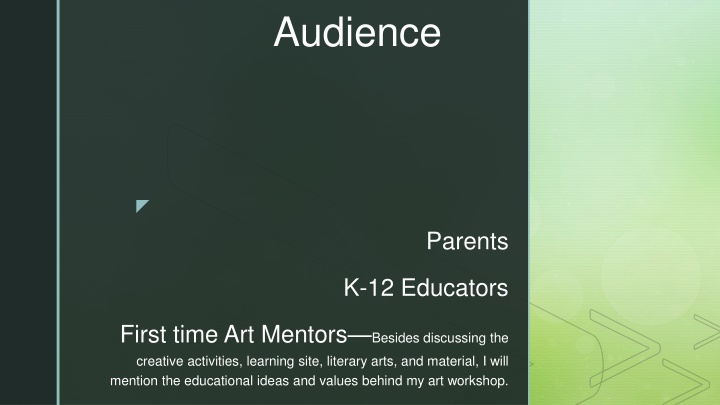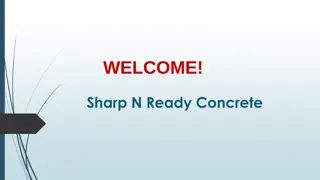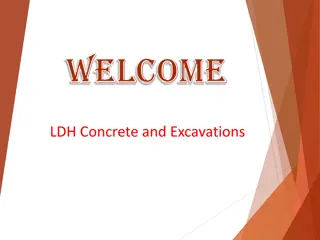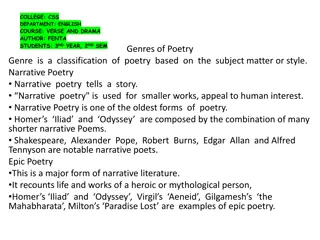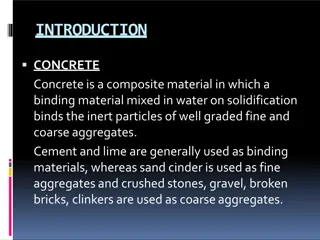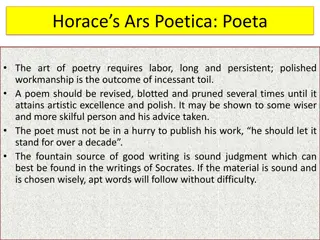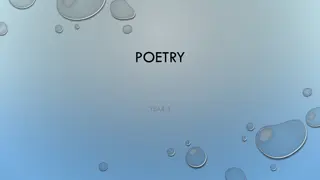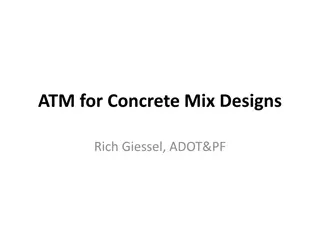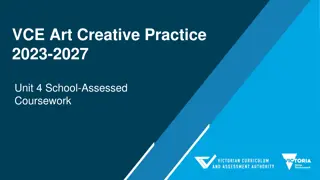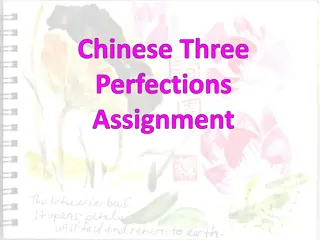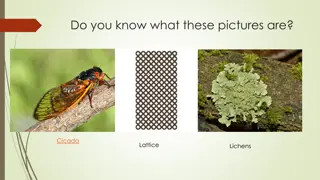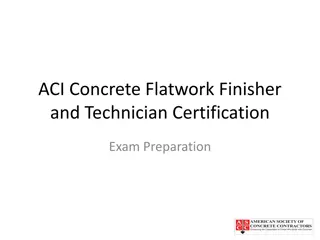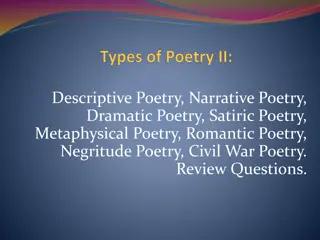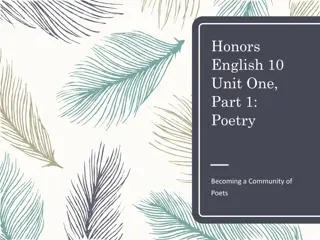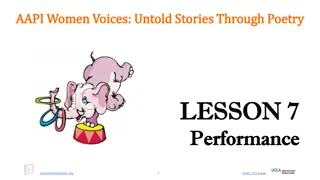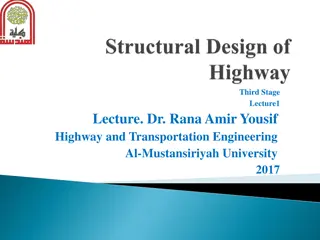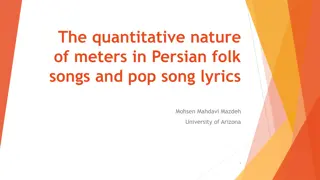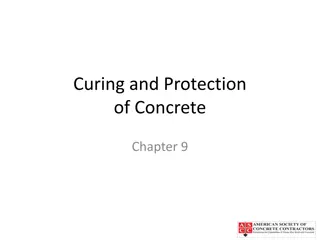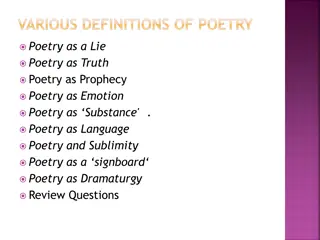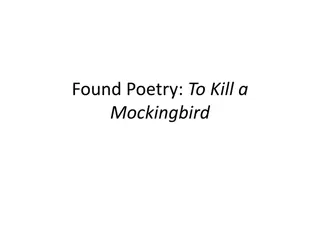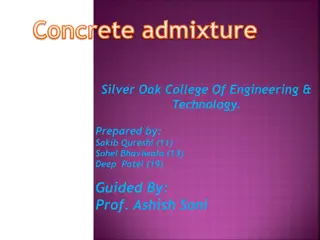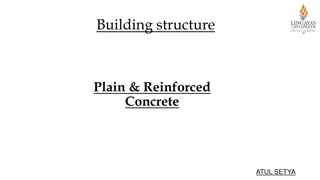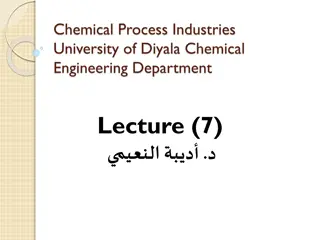Creative Exploration in Art Workshop: Educational Ideas and Concrete Poetry
Explore educational values in art workshops by fostering creativity, self-examination, and academic skills. Dive into the world of concrete poetry, using cubes to create engaging and visual poems. Engage in various creative tasks to personalize your artistic journey.
Download Presentation

Please find below an Image/Link to download the presentation.
The content on the website is provided AS IS for your information and personal use only. It may not be sold, licensed, or shared on other websites without obtaining consent from the author.If you encounter any issues during the download, it is possible that the publisher has removed the file from their server.
You are allowed to download the files provided on this website for personal or commercial use, subject to the condition that they are used lawfully. All files are the property of their respective owners.
The content on the website is provided AS IS for your information and personal use only. It may not be sold, licensed, or shared on other websites without obtaining consent from the author.
E N D
Presentation Transcript
Audience Parents K-12 Educators First time Art Mentors Besides discussing the creative activities, learning site, literary arts, and material, I will mention the educational ideas and values behind my art workshop.
Workshop Art happens by us, not just through us. During the creative process, we should stress self-examination. Use the creative tasks to encourage academic values such as persistence, independence, risk-taking, open-mindedness, humor, elaboration, and curiosity. We should focus on sharing and establishing a creative place that is fun, collaborative and relational. Will your creative place be more like a playground with expected ways of playing or imagining? Or will it be more like a play-scape, more like a child s secret play area or backyard where the rules are not as prescribed?
Concrete Poetry What is concrete poetry? Concrete poems are objects composed of words, letters, colors, and typefaces, in which graphic space plays a central role in both design and meaning. Concrete poets [experiment] boldly with language, incorporating visual, verbal, kinetic, and sonic elements. (https://blogs.getty.edu/iris/what-is-concrete-poetry/) You can use your cube to put into action words, letters, colors, typeface, etc. You can have fun with wordplay, letter-play, sound-play, spatial play (three-dimensionality). You can be playful with different forms of media and create multi-sensory experiences for the viewer/listener. A poem can have multiple versions; you can use different materials to create new compositions. For poets who are used to writing poems, maybe you can think of reducing or condensing your text. Think of smaller word cluster, letter and type cluster, or smaller sample of sound. For an example, let me refer to the Scottish poet Ian Hamilton Finlay and share his ideas about poetry. He saw poets as practical, artistically using the common things around them. He loved ordinary things and celebrated them in his art. For example, he made toys that were simple and mysterious. You can think of your poetic cube as a toy for our imaginations. As a gardener, Finlay said a garden is a place to see and explore possibilities. Also, a garden is a wonderful example of action or of transforming objects into art. You can think of your poetic cubes in these ways as well.
Creative Tasks I am giving you several options I am not trying to confuse you; I want you to have choices. As a workshop leader, I am not interested in norming or managing how closely you follow directions. I am more interested in how you might personalize the creative tasks for your needs and interests. Creative Task A: Use your cube to create a riddle for us. Give us clues, images, stories, so we can guess if you are describing an animal, a song, a person. Your cube is a puzzle for us to hold in our hands and ponder. Creative Task B: Draw and tell a story about where your footprints have been, where they mostly stand now, and where they will be in the future. Use your six-sided cube to represent your footprint journeys. Creative Task C: Create a portrait of your childhood What activity do you see yourself doing? What site or sites best describe a key feature of your childhood? What sounds do you hear? What colors define an aspect of your childhood? What tree or other landmark (natural or manufactured) is in the center of your childhood activities? Creative Task D: Select a phrase from your native, ancestral, or home language and translate it for us. Provide drawings and definitions of key words. You are creating a colorful and personal dictionary on your cube. Also, please use the phrase in context or put the phrase into action.
I have additional suggestions for Creative Task D: Do a little research and find the native language or languages of your local area and use it for your cube. For instance, it would be great to see and hear a cube featuring Serrano and Cahuilla, the native languages in my area. If you are interested in different linguistic communities, you can use your cube to create your own personal Difrasismos,* which means creating semantic couplets, something we see in Old English and Nahuatl. If you have studied Old English Poetry, you are aware of this kind of pairing of two nouns or kenning. In Beowulf, one comes across whale-road for sea. Nahuatl speakers have a unique way of thinking when they pair two elements to create or express something new. For example, in Nahuatl, speakers bring together water and mountain to refer to the city. And heart in Nahuatl brings together eye and face, thus combining two essential ideas. For them, the eye and face suggest perception and emotion, which for them equals the heart. In Nahuatl, scholars tell us that this kind of compounding was a special practice in that the Pre-Hispanic people who gave importance to a word by bringing two words that had a special meaning in their culture. What two words represent the heart for you? What two words best represent your city? *Difrasismo is a term coined by ngel Mar a Garibay Kintana. Please read Dr. Mercedes Montes de Oca Vega s explanation and examples of Diphrases or couplets in N huatl. (http://www.mexicolore.co.uk/aztecs/language/diphrases-or-couplets-in-nahuatl)
https://www.mexicolore.co.uk/aztecs/language/diphrases-or-couplets-in-nahuatlhttps://www.mexicolore.co.uk/aztecs/language/diphrases-or-couplets-in-nahuatl In atl in tepet In ixtli in yollotl Eye/Face, Heart = Person Water, Mountain = the City The sense is made by combining two essential ideas: vitality and emotion (yol) and perception (ix). Here s another example of disfrasismos: One mouth, one belly (Totontepecano) = to speak with sincerity. With one lip, with two lips (Classic Nahuatl) = to speak indirectly.
Questions to explore with your cubes: How can you free words from the line or your sense of syntax? How can you place words into objects or the landscape? How can you disrupt the ways we read words? What technology is available to you as you produce or create poems? Have you explored aspects of digital poetics, poems on screens? We know that Concrete Poetry depends a great deal on the typewriter, the tape recorder, and the camera. As you represent your ideas and feelings in poetry, what technology, media, and materials (such as stone, wood, fabric) appeal to you as a poet/maker?
Questions from the Audience Juan Delgado Email: juandelgado.poet@gmail.com Website: http://www.juandelgadopoet.com/
